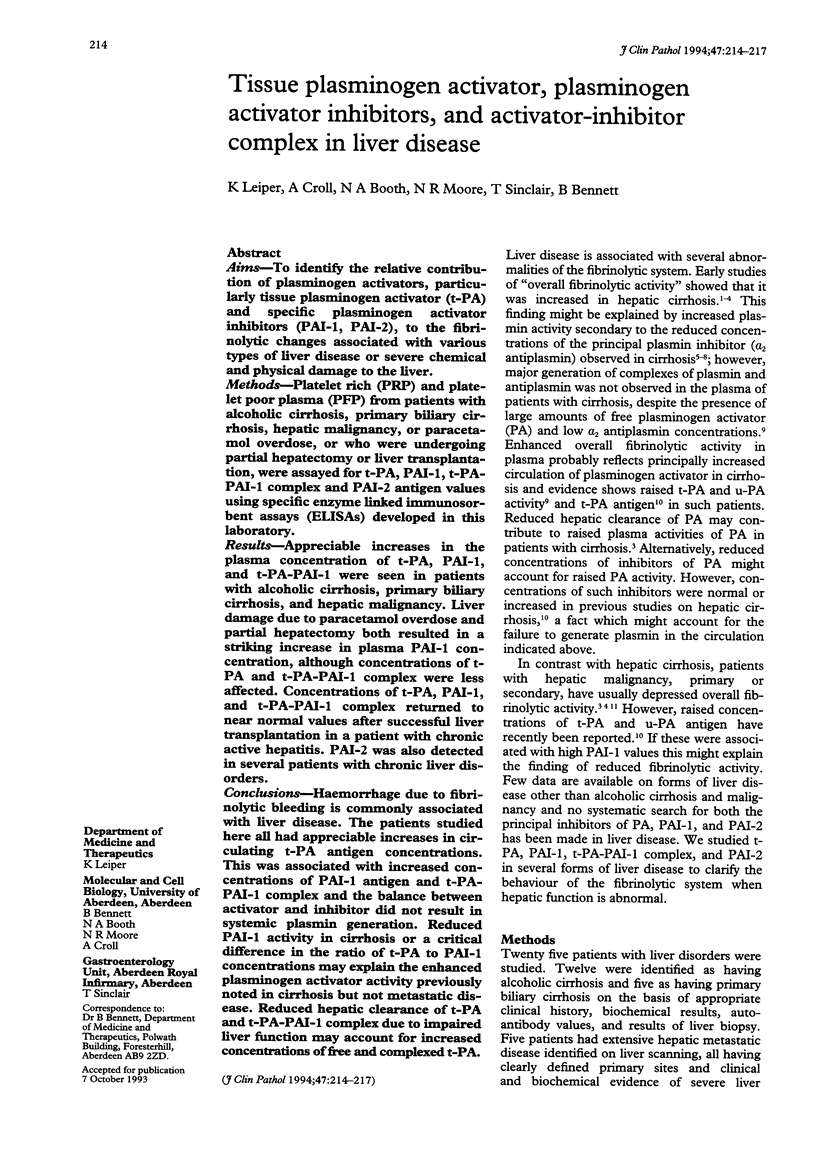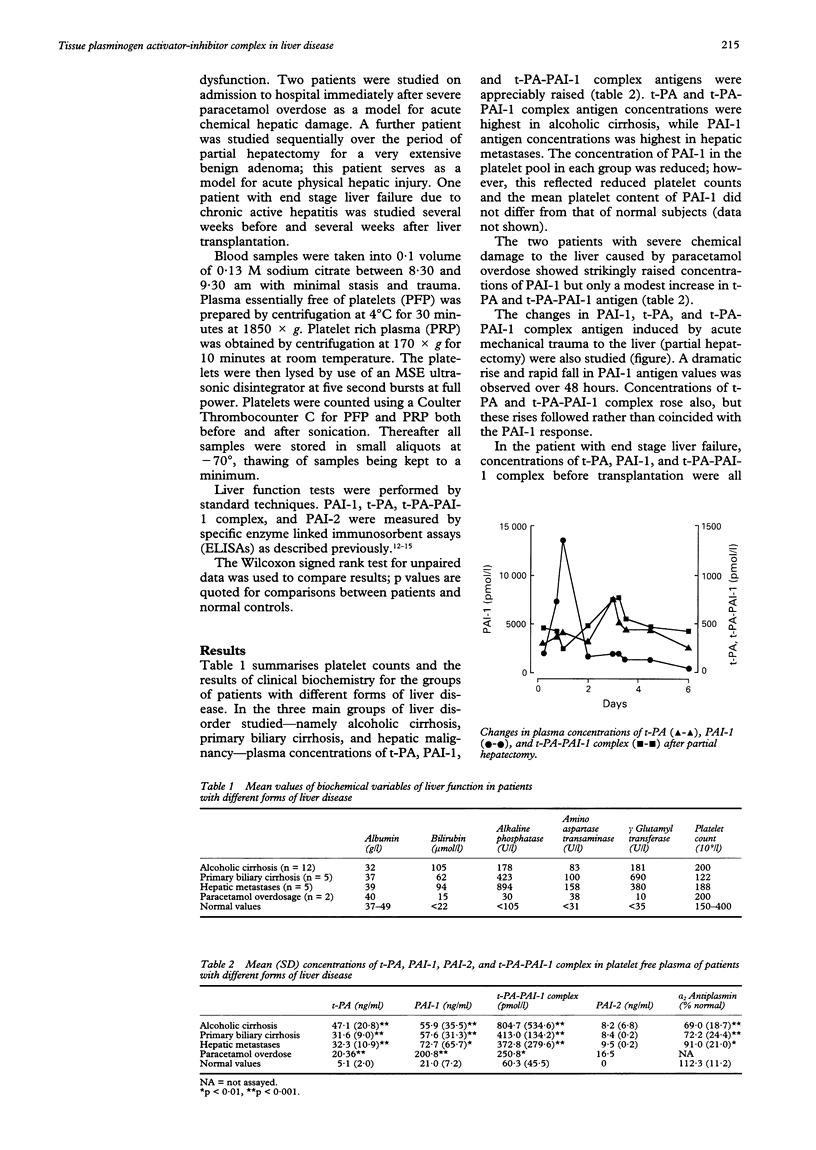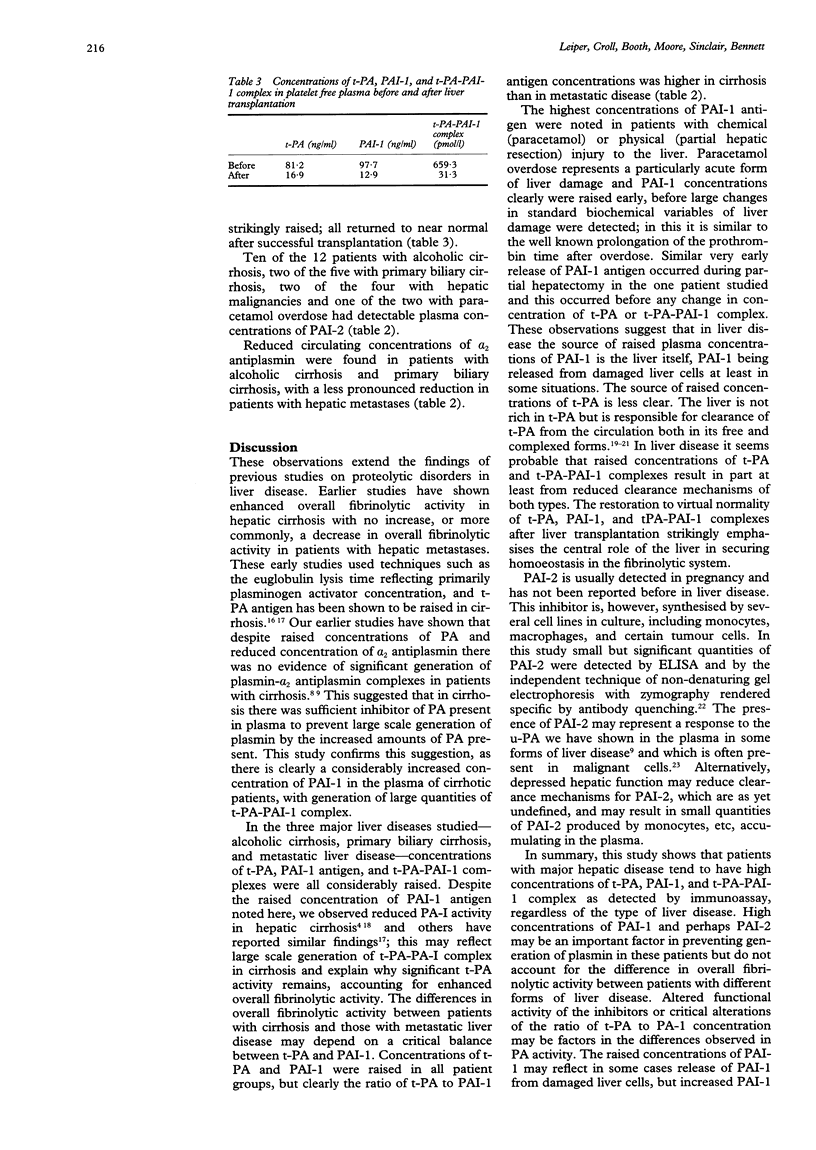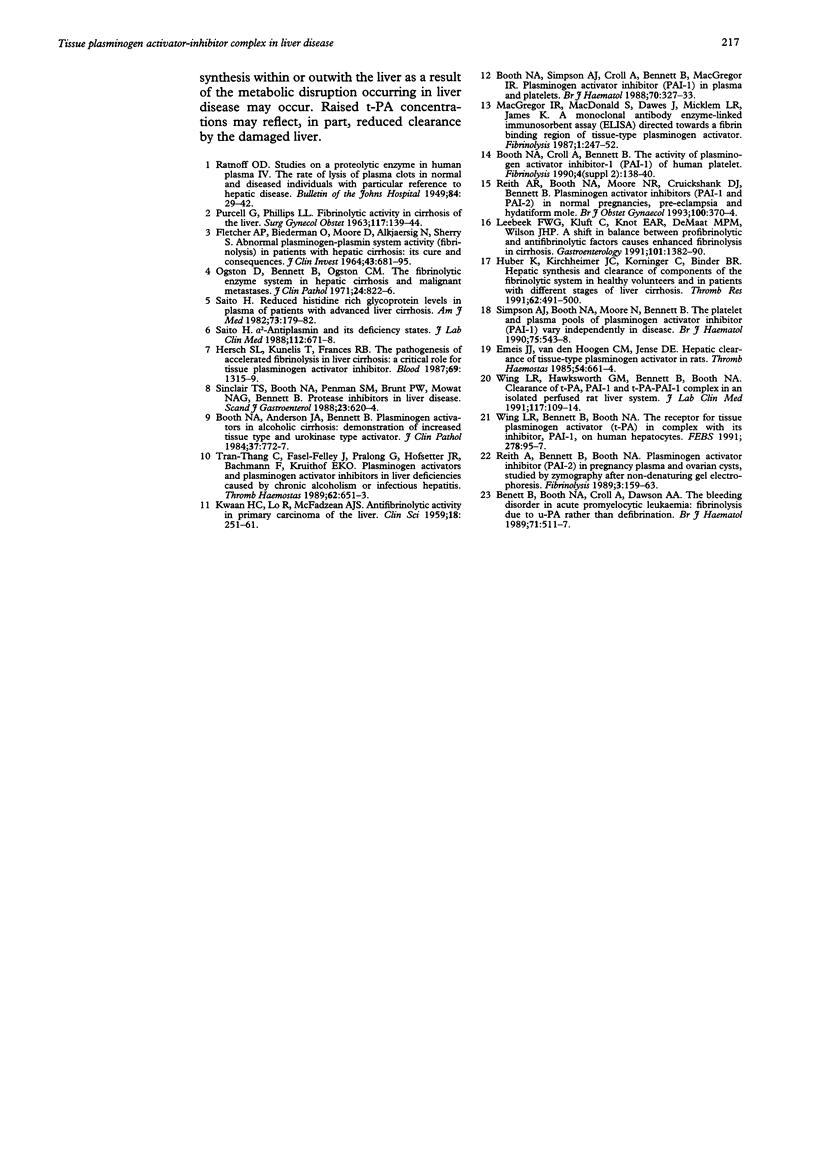Abstract
AIMS--To identify the relative contribution of plasminogen activators, particularly tissue plasminogen activator (t-PA) and specific plasminogen activator inhibitors (PAI-1, PAI-2), to the fibrinolytic changes associated with various types of liver disease or severe chemical and physical damage to the liver. METHODS--Platelet rich (PRP) and platelet poor plasma (PFP) from patients with alcoholic cirrhosis, primary biliary cirrhosis, hepatic malignancy, or paracetamol overdose, or who were undergoing partial hepatectomy or liver transplantation, were assayed for t-PA, PAI-1, t-PA-PAI-1 complex and PAI-2 antigen values using specific enzyme linked immunosorbent assays (ELISAs) developed in this laboratory. RESULTS--Appreciable increases in the plasma concentration of t-PA, PAI-1, and t-PA-PAI-1 were seen in patients with alcoholic cirrhosis, primary biliary cirrhosis, and hepatic malignancy. Liver damage due to paracetamol overdose and partial hepatectomy both resulted in a striking increase in plasma PAI-1 concentration, although concentrations of t-PA and t-PA-PAI-1 complex were less affected. Concentrations of t-PA, PAI-1, and t-PA-PAI-1 complex returned to near normal values after successful liver transplantation in a patient with chronic active hepatitis. PAI-2 was also detected in several patients with chronic liver disorders. CONCLUSIONS--Haemorrhage due to fibrinolytic bleeding is commonly associated with liver disease. The patients studied here all had appreciable increases in circulating t-PA antigen concentrations. This was associated with increased concentrations of PAI-1 antigen and t-PA-PAI-1 complex and the balance between activator and inhibitor did not result in systemic plasmin generation. Reduced PAI-1 activity in cirrhosis or a critical difference in the ratio of t-PA to PAI-1 concentrations may explain the enhanced plasminogen activator activity previously noted in cirrhosis but not metastatic disease. Reduced hepatic clearance of t-PA and t-PA-PAI-1 complex due to impaired liver function may account for increased concentrations of free and complexed t-PA.
Full text
PDF



Selected References
These references are in PubMed. This may not be the complete list of references from this article.
- Bennett B., Booth N. A., Croll A., Dawson A. A. The bleeding disorder in acute promyelocytic leukaemia: fibrinolysis due to u-PA rather than defibrination. Br J Haematol. 1989 Apr;71(4):511–517. doi: 10.1111/j.1365-2141.1989.tb06311.x. [DOI] [PubMed] [Google Scholar]
- Booth N. A., Anderson J. A., Bennett B. Plasminogen activators in alcoholic cirrhosis: demonstration of increased tissue type and urokinase type activator. J Clin Pathol. 1984 Jul;37(7):772–777. doi: 10.1136/jcp.37.7.772. [DOI] [PMC free article] [PubMed] [Google Scholar]
- Booth N. A., Simpson A. J., Croll A., Bennett B., MacGregor I. R. Plasminogen activator inhibitor (PAI-1) in plasma and platelets. Br J Haematol. 1988 Nov;70(3):327–333. doi: 10.1111/j.1365-2141.1988.tb02490.x. [DOI] [PubMed] [Google Scholar]
- Emeis J. J., van den Hoogen C. M., Jense D. Hepatic clearance of tissue-type plasminogen activator in rats. Thromb Haemost. 1985 Oct 30;54(3):661–664. [PubMed] [Google Scholar]
- FLETCHER A. P., BIEDERMAN O., MOORE D., ALKJAERSIG N., SHERRY S. ABNORMAL PLASMINOGEN-PLASMIN SYSTEM ACTIVITY (FIBRINOLYSIS) IN PATIENTS WITH HEPATIC CIRRHOSIS: ITS CAUSE AND CONSEQUENCES. J Clin Invest. 1964 Apr;43:681–695. doi: 10.1172/JCI104953. [DOI] [PMC free article] [PubMed] [Google Scholar]
- Hersch S. L., Kunelis T., Francis R. B., Jr The pathogenesis of accelerated fibrinolysis in liver cirrhosis: a critical role for tissue plasminogen activator inhibitor. Blood. 1987 May;69(5):1315–1319. [PubMed] [Google Scholar]
- Huber K., Kirchheimer J. C., Korninger C., Binder B. R. Hepatic synthesis and clearance of components of the fibrinolytic system in healthy volunteers and in patients with different stages of liver cirrhosis. Thromb Res. 1991 Jun 1;62(5):491–500. doi: 10.1016/0049-3848(91)90022-o. [DOI] [PubMed] [Google Scholar]
- KWAAN H. C., LO R., MCFADZEAN A. J. Antifibrinolytic activity in primary carcinoma of the liver. Clin Sci. 1959 May;18:251–261. [PubMed] [Google Scholar]
- Leebeek F. W., Kluft C., Knot E. A., de Maat M. P., Wilson J. H. A shift in balance between profibrinolytic and antifibrinolytic factors causes enhanced fibrinolysis in cirrhosis. Gastroenterology. 1991 Nov;101(5):1382–1390. doi: 10.1016/0016-5085(91)90092-y. [DOI] [PubMed] [Google Scholar]
- PURCELL G., Jr, PHILLIPS L. L. FIBRINOLYTIC ACTIVITY IN CIRRHOSIS OF THE LIVER. Surg Gynecol Obstet. 1963 Aug;117:139–144. [PubMed] [Google Scholar]
- Reith A., Booth N. A., Moore N. R., Cruickshank D. J., Bennett B. Plasminogen activator inhibitors (PAI-1 and PAI-2) in normal pregnancies, pre-eclampsia and hydatidiform mole. Br J Obstet Gynaecol. 1993 Apr;100(4):370–374. doi: 10.1111/j.1471-0528.1993.tb12982.x. [DOI] [PubMed] [Google Scholar]
- Saito H. Alpha 2-plasmin inhibitor and its deficiency states. J Lab Clin Med. 1988 Dec;112(6):671–678. [PubMed] [Google Scholar]
- Saito H., Goodnough L. T., Boyle J. M., Heimburger N. Reduced histidine-rich glycoprotein levels in plasma of patients with advanced liver cirrhosis. Possible implications for enhanced fibrinolysis. Am J Med. 1982 Aug;73(2):179–182. doi: 10.1016/0002-9343(82)90175-9. [DOI] [PubMed] [Google Scholar]
- Simpson A. J., Booth N. A., Moore N. R., Bennett B. The platelet and plasma pools of plasminogen activator inhibitor (PAI-1) vary independently in disease. Br J Haematol. 1990 Aug;75(4):543–548. doi: 10.1111/j.1365-2141.1990.tb07796.x. [DOI] [PubMed] [Google Scholar]
- Sinclair T. S., Booth N. A., Penman S. M., Brunt P. W., Mowat N. A., Bennett N. B. Protease inhibitors in liver disease. Scand J Gastroenterol. 1988 Jun;23(5):620–624. doi: 10.3109/00365528809093922. [DOI] [PubMed] [Google Scholar]
- Tran-Thang C., Fasel-Felley J., Pralong G., Hofstetter J. R., Bachmann F., Kruithof E. K. Plasminogen activators and plasminogen activator inhibitors in liver deficiencies caused by chronic alcoholism or infectious hepatitis. Thromb Haemost. 1989 Sep 29;62(2):651–653. [PubMed] [Google Scholar]
- Wing L. R., Bennett B., Booth N. A. The receptor for tissue plasminogen activator (t-PA) in complex with its inhibitor, PAI-1, on human hepatocytes. FEBS Lett. 1991 Jan 14;278(1):95–97. doi: 10.1016/0014-5793(91)80092-h. [DOI] [PubMed] [Google Scholar]
- Wing L. R., Hawksworth G. M., Bennett B., Booth N. A. Clearance of t-PA, PAI-1, and t-PA-PAI-1 complex in an isolated perfused rat liver system. J Lab Clin Med. 1991 Feb;117(2):109–114. [PubMed] [Google Scholar]


